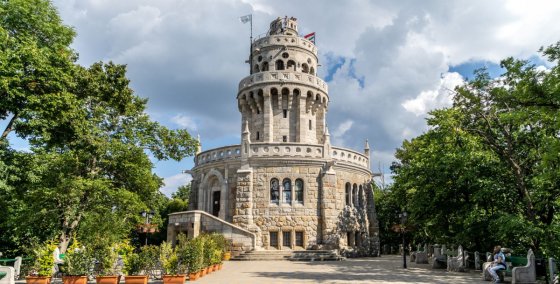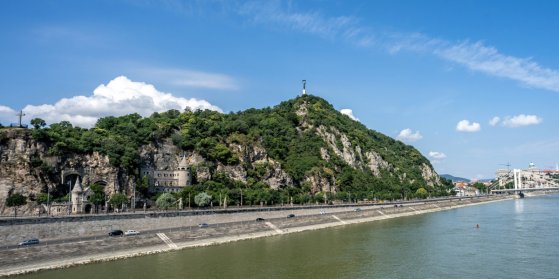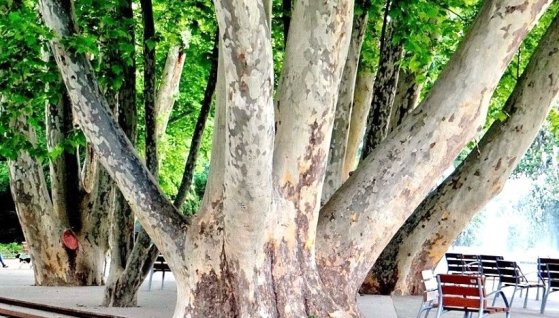 The „intertwined history” of the bridges and the city of Budapest
Which ideas and events have shaped the fate of bridges of Budapest and the cityscape? Alongside many other interesting facts, this question is also answered this newly published book by the Budapest City Archives, which introduces the history of bridges in Budapest.
The „intertwined history” of the bridges and the city of Budapest
Which ideas and events have shaped the fate of bridges of Budapest and the cityscape? Alongside many other interesting facts, this question is also answered this newly published book by the Budapest City Archives, which introduces the history of bridges in Budapest.
PestBuda
 New sports centre in City Park completed and opened to the public
New sports centre in City Park completed and opened to the public
September 3, 2020 at 10:00 AM
The City Parks Sports Centre has been completed. Located in the south-eastern area of the park – near the intersection of Ajtósi Dürer Way and Dózsa György Road, the thirty-six-thousand square metre accessible sports centre contains football pitches, basketball courts, climbing walls and ping pong and teqball tables.
One of the most beautiful churches in Budapest
August 30, 2020 at 9:00 AM
The parish church of St. Elizabeth of Hungary located on Rózsák Square, in the 7th District, will also be a venue of the International Eucharistic Congress next year. The building with a capacity of 2,560 people is a masterpiece by Imre Steindl, the designer of the Parliament, and one of the largest neo-Gothic churches in Budapest.
Water meters were installed 100 years ago to reduce water waste
August 25, 2020 at 1:00 PM
It is hard to imagine today that drinking water from the tap was not always a basic service. Mihály Kajlinger, born 160 years ago, has indisputable merit in the organisation and construction of Budapest's water supply. His name is associated with the plans for the capital's large sewage pumping station, sewerage, and water supply network, but water consumption meters were also introduced at his suggestion to curb water waste. His main work, the waterworks of Káposztásmegyer, was the most beautiful and modern waterworks in contemporary Europe.
New Drug Research Centre to open next year in former hospital building
August 24, 2020 at 9:00 AM
The capital has few hospital buildings opened more than a hundred years ago that do not need to be thoroughly renovated, remodelled or modernised. There was also a period, not so long ago, when such institutions were closed rather than maintained. But the list of empty unused buildings also goes on and on, as they await new use of demolition. Fortunately, there are already examples of healthcare buildings being renovated without major changes in function. An example is the former Schöpf-Merei Ágoston Hospital.
Újpest City Hall 120 years old
August 22, 2020 at 9:00 AM
One of the symbols of Újpest, the town hall, which was inaugurated 120 years ago, on 21 August 1900, was designed by the outstanding architects of the age, Ármin Hegedűs and Henrik Böhm. Originally a town hall and then city hall from 1907, the historic building, which bears Art Nouveau features, is still in the service of the local population.
The bells of Saint Stephen's Basilica – Hungarian and German masterpieces
August 21, 2020 at 9:00 AM
The historical value of the former and present bells in Saint Stephen's Basilica in Budapest is significant in terms of ecclesiastical, industrial and national history. Today’s large bell was donated by the German people in 1990 and was made by Perner in Passau. The bell was consecrated on 20 August 1990, thirty years ago. It is the largest bell in Hungary today.
Brides, stuntmen and sandbags have travelled on the Chairlift – Budapest's most unique means of public transport
August 19, 2020 at 10:00 AM
The János Hill chairlift is one of Budapest's most interesting means of transport and has been serving the city since 19 August 1970. There are several interesting facts connected to it. Few know that the first “passengers” on the chair lift were sandbags. A wedding was once held up in the air, and the Trapper jeans brand also shot a commercial on the lift, with a stuntman travelling above the city standing up.
Statue of Saint Emeric unveiled 90 years ago – Despite several plans, the memorial was never moved
August 16, 2020 at 10:00 AM
The statue of Saint Emeric erected in 1930 has survived the storms of history. Later it survived the battles of 1956 and the attacks of the socialist ideology untouched. Although its demolition was raised several times, the statue by Zsigmond Kisfaludi Strobl still stands where it was unveiled 90 years ago, as part of the events commemorating the 900th anniversary of Saint Emeric's death.
A footprint of Budapest – Stunning paving stones hide in old building around Budapest
August 15, 2020 at 10:00 AM
How many times have we been told to watch out steps? The saying can be useful when walking the streets of Budapest near open doorways because the capital's architecture is more than the facades facing the street! Entering through the gates, we drop into a closed world, where those paying attention will discover many beautiful details. The most colourful of these, in addition to painted glass windows, are floor pavings.
Most of the National Electric Load Distributor in the Castle has been demolished
August 14, 2020 at 9:00 AM
The demolition of the controversial-looking industrial building next to the Bécsi Kapu Square Palace of the Hungarian National Archives has progressed quickly in recent weeks. Only the tower, part of the iron structure and a firewall remain. The former National Electric Load Distributor that has been in a dilapidated condition for a long time will be replaced by a house
Motorways through the city – Fifty years ago prioritising cars was a modern choice
August 13, 2020 at 10:00 AM
A few decades ago, a highway network was planned to criss-cross the city centre. Motorists could have passed through the city centre without hindrance and reached the motorways leading out of the city, which would also have been connected by a two-level ring motorway. Today, when the goal is to have as few cars as possible in the city centre, the plans from 50 years ago are interesting.
How have the bridges of Budapest changed after their construction?
August 10, 2020 at 12:00 PM
Pestbuda's summary presenting the reconstruction of the Chain Bridge in 1914 received many comments about the bridges of Budapest, their modifications and redesigns. Please join us on a glance through which bridge has changed in the decades since its construction.
A Day of Memorials will be held on 12 sites around Budapest
August 9, 2020 at 11:00 AM
Fans of history and culture are invited to 70 locations around the country on 29 August. Guided walks, performances, concerts and many other attractions are being organised at national and historical memorials.
In the footsteps of Kölcsey – The poet who wrote the national anthem of Hungary was born 230 years ago
August 8, 2020 at 4:00 PM
Ferenc Kölcsey, born 230 years ago, was one of the greatest figures of Hungarian literature and public life in the Reform Period. His poem, Himnusz ('hymn'), which became the Hungarian national anthem, elevated him among the immortals of Hungarian culture. Despite this, his memory was not marked in Budapest by any public statue or plaque for a long time. Pestbuda examines the current memorial to the great poet in Budapest.
The lid of a Venetian cure-all and a medieval staircase have been unearthed in the newest cultural area in Buda Castle
August 7, 2020 at 11:00 AM
The outdoor site of 9 Táncsics Street has been reborn as the T9 - The First Bastion archaeological exhibition and cultural community space. The former József Barracks and Prison building is continuously revealing the layers of its history. During the current archaeological excavation, the remains of a medieval and Ottoman building that used to stand here have emerged from under the floor of the house.
The Gothic-Revival wonders of Budapest
August 6, 2020 at 9:00 AM
The image of Budapest today is defined by a prolific period, the architecture of dualism. The most famous buildings of the capital, such as the Fisherman's Bastion, the Opera House, the Parliament and Saint Stephen's Basilica, were built in the second half of the 19th century. This period is characterized by a high degree of stylistic pluralism. Join PestBuda on a walk through the most stunning buildings in Budapest.
Lajos Batthyány's public reburial took place 150 years ago – The 42-year-old Prime Ministers was buried in secret after being executed
August 5, 2020 at 1:00 PM
The execution of Count Lajos Batthyány, the first elected Hungarian prime minister, remains an indescribable act of retaliation after the war of independence. The prime minister was buried in secret and then reburied publicly 21 years later, in 1870, with great pomp. The nation laid him to rest in a funeral fitting the difficult diplomatic solution worthy of a great politician.
The dream of connecting Buda and Pest – Creator of the first Hungarian steamboat designed a bridge between the cities
August 3, 2020 at 1:00 PM
Antal Bernhard, the creator of Carolina, the first Hungarian steamboat, also designed a bridge design to connect the cities of Pest and Buda. Before the construction of the Chain Bridge, nearly two dozen proposals were made on how to bridge the river, and among these, Bernhard’s plan was an important idea because it could actually have worked.
The highest point of Budapest – Elizabeth Lookout turns 110
August 2, 2020 at 3:00 PM
One of Sisi's favourite places to visit in Budapest. The highest point of the city houses one of Budapest's most popular lookout towers, the Elizabeth Lookout. The building, designed by Pál Kluzinger and Frigyes Schulek, was opened 110 years ago. Pestbuda climbed János Hill to honour the anniversary.
A neglected landmark – A walk on Gellért Hill
August 1, 2020 at 1:30 PM
Despite it being a symbol of Budapest, a popular walking destination, and a nature reserve in the city's heart, Gellért Hill has been neglected for decades. Unfortunately, the situation is beyond slight renovation – a complete replanning and reconstruction are needed.
The Chain Bridge, a symbol of the country completely demolished in 1914
July 27, 2020 at 12:00 PM
During the renovation of the Chain Bridge, it will be necessary to go back to the plans of 1914. But why will they follow the 1914 version when the bridge was built between 1839-1849?
Jenő Cholnoky, one of the greatest Hungarian geographers, born 150 years ago
July 23, 2020 at 9:00 AM
Every day we walk past buildings whose past we know nothing about. The block of flats delimited by 29 Rákóczi Road - 1 Gyulai Pál Street - 4 Stáhly Street are similar. Today Pestbuda the site because the famous geographer Jenő Cholnoky was born 150 years ago and 100 years ago, in 1920, he moved here. His work is immense, yet he is mostly associated with the study of China and Lake Balaton. Look at his connections in Budapest with Pestbuda.
How did cars get into the City Park which has also been suggested as a site for a Formula 1 track?
July 22, 2020 at 1:00 PM
The City Park will be car-free, and the Kós Károly Promenade will be closed. But how did cars get into the City Park at all? Why does a busy main road lead through City Park, and how did it become a car park?
A little Genoa on Gellért Hill
July 21, 2020 at 11:00 AM
The Hegedüs Villa or originally the Schoch Villa is well known in Budapest, although few people know by its name. The mass of the building rises above the statue depicting Saint Gerard and the waterfall, so it is immediately noticeable when people drive from Pest to Buda across Erzsébet Bridge. Its medieval forms are less typical of early 20th century Hungarian architecture, according to urban legend, it is a copy of an Italian building. Pestbuda now reveals if the legend is true.
Pasarét Franciscan Church to be renovated and expanded
July 20, 2020 at 7:00 PM
The Franciscan Church of St. Anthony of Padua in Pasarét is to be renovated alongside the attached monastic buildings and library. Modernisation works will also include the creation of new community spaces. Plans are to renovate the parish in the autumn, and complete work on the Church and monastic structures in June 2021.
The Székely national anthem was first played in Budapest – Memorial plaque unveiled on the lyricist's home
July 19, 2020 at 3:00 PM
While many Hungarians know the lyrics to the Székely national anthem, while the work written soon after the Treaty of Trianon was signed quickly became symbolic of Hungarian unity, few know the name of the writer who originally wrote the lyrics: György Csanády. To honour the writer's memory, born 125 years ago, a memorial plaque has been unveiled on the 12th-district house he lived in.
Mobile app of famous trees in Budapest updated
July 18, 2020 at 11:00 AM
The BP Fatár [Tree Store] app has been updated and now includes the description of 100 famous trees, 38 local natural conservation areas and natural treasures in Budapest with pictures. The addition to the application were announced by Főkert at a press conference on Friday.
"No one prepared us for the breathtaking experience" - The Riding Hall in Buda Castle Reborn
July 17, 2020 at 9:00 AM
People have admired the Lovarda ('riding hall') in Buda Castle, recently completed within the framework of the National Hauszmann Program, from the outside. They have not been able to look around inside yet, only see the beautiful interiors in photos. Pestbuda editors had the opportunity to visit the building as part of a guided tour. Alajos Hauszmann designed the riding hall, which was completed in 1901. Hence it is no surprise that the guided tour was called Hauszmann's Horses on the website of the National Hauszmann Program.
From Pest to Gellért Hill by funicular
July 16, 2020 at 3:00 PM
Reaching Buda from Pest downtown at the end of the 19th century was not easy. Climbing to the top of Gellért Hill had similar issues. These two problems would have been solved by the truly spectacular idea of János Ruppenthal, i.e., building a bridge and a funicular.
Renovation of Hall of Art to begin as Government confirm priority status
July 15, 2020 at 10:00 AM
The Government has declared the renovation of the Hall of Arts to be a project of national economic importance and investment of high public interest. The building was originally constructed in 1896 as part of the events to commemorate the millennium of Hungarians living in the Carpathian Basin. However, when work will begin on the building, designed by Albert Schickedanz and inaugurated by Franz Joseph, is currently unknown.
More articles
 The „intertwined history” of the bridges and the city of Budapest
Which ideas and events have shaped the fate of bridges of Budapest and the cityscape? Alongside many other interesting facts, this question is also answered this newly published book by the Budapest City Archives, which introduces the history of bridges in Budapest.
The „intertwined history” of the bridges and the city of Budapest
Which ideas and events have shaped the fate of bridges of Budapest and the cityscape? Alongside many other interesting facts, this question is also answered this newly published book by the Budapest City Archives, which introduces the history of bridges in Budapest.
 The Bridge Report, which brought a turning point in the history of Budapest
A travel report that changed the history of Pest and Buda, as well as Hungary. The little book contributed to the change of half a thousand years of legal customs and the implementation of an investment of unprecedented size and technical quality. This book was The Bridge Report [Hídjelentés in Hungarian].
The Bridge Report, which brought a turning point in the history of Budapest
A travel report that changed the history of Pest and Buda, as well as Hungary. The little book contributed to the change of half a thousand years of legal customs and the implementation of an investment of unprecedented size and technical quality. This book was The Bridge Report [Hídjelentés in Hungarian].
 Drama on the university wall - The heroic monument was planned 95 years ago
In the constant hustle and bustle of the Egyetem Square in Pest, the students may not even notice the monument that decorates the short section of wall between the church and the central building of ELTE. However, it commemorates their predecessors, the heroes who fought for their country in World War I, and those who heroically helped them. The first design of the dramatically collapsing soldier was born in 1928, ninety-five years ago.
Drama on the university wall - The heroic monument was planned 95 years ago
In the constant hustle and bustle of the Egyetem Square in Pest, the students may not even notice the monument that decorates the short section of wall between the church and the central building of ELTE. However, it commemorates their predecessors, the heroes who fought for their country in World War I, and those who heroically helped them. The first design of the dramatically collapsing soldier was born in 1928, ninety-five years ago.





























